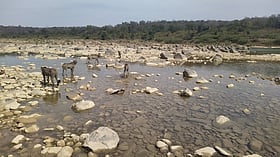Cheetahs Relocated From Kuno to Gandhi Sagar Sanctuary
National NationalPosted by AI on 2025-04-20 11:46:35 | Last Updated by AI on 2025-08-04 14:27:31
Share: Facebook | Twitter | Whatsapp | Linkedin Visits: 5

After two years in Madhya Pradesh's Kuno National Park, two cheetahs are embarking on a new chapter. Prabhash and Pavak, both six years old, will reach their new home in the Gandhi Sagar Sanctuary on Sunday evening, marking a significant step in India's ambitious cheetah reintroduction program.
Kuno National Park, initially chosen as the primary site for the project, has faced challenges, including territorial disputes with leopards and a few cheetah deaths. The decision to relocate Prabhash and Pavak to Gandhi Sagar Sanctuary comes after careful consideration of the animals' welfare and the overall success of the reintroduction initiative. The sanctuary, situated on the banks of the Chambal River, offers a different terrain and prey base, potentially providing a more suitable environment for the cheetahs. The transfer process, overseen by wildlife experts and veterinarians, is designed to minimize stress on the animals and ensure a smooth transition.
The relocation to Gandhi Sagar is not simply a change of scenery; it represents an adaptive management strategy for the cheetah reintroduction program. The move will allow scientists to study cheetah behavior in a different habitat and gather valuable data for future relocations. The vast expanse of the sanctuary, with its diverse flora and fauna, presents a unique opportunity to observe how cheetahs adapt and thrive in a new environment. This new phase also signifies the importance of flexibility and scientific assessment in conservation efforts. By constantly evaluating and adjusting strategies based on real-time observations, wildlife authorities aim to maximize the chances of a successful, long-term cheetah reintroduction in India. The move also highlights the complex interplay of factors involved in wildlife management, including habitat suitability, interspecies dynamics, and long-term sustainability.
The success of Prabhash and Pavak's relocation will be closely monitored, and the knowledge gained will inform future decisions regarding cheetah introductions. The team involved recognizes the importance of this move not just for these two cheetahs, but for the broader aim of establishing a self-sustaining cheetah population in India. This relocation underscores the commitment of conservationists and authorities to learn, adapt, and refine their approach to ensure the long-term survival of these magnificent creatures in their historical range. The future of cheetahs in India hinges on such careful planning and adaptive management.
Search
Categories
- Sports
- Business
- History
- Politics
- International
- Science & Technology
- Social Issues
- Disaster Management
- Current Affairs
- Education
- Startup Business
- Startup News
- Awards
- Community Services
- Fundraising Events
- Volunteer Services
- Health Initiatives
- Innovations and Initiatives
- In News
- dummybanners
- Awards
- Partners
- Products
- Press Releases
- News
- Fast Check
- South
- సినిమా
- Gallery
- Sunday Chronicle
- Hyderabad Chronicle
- లైఫ్ స్టైల్
- National
- క్రైం
- ట్రెండింగ్
- జాబ్స్
- అంతర్జాతీయo
- బిజినెస్
- రాజకీయం
- బిజినెస్
- సంపాదకీయం
- నవ్య
- చిత్ర జ్యోతి
- క్రీడలు
- జాతీయం
- తెలంగాణ
- తాజా వార్తలు
- మన పార్టీ
- మన నాయకత్వం
- మన విజయాలు
- డౌన్లోడ్స్
- మీడియా వనరులు
- కార్యకర్తలు
- North East Skill Center News
- Government Schemes
- Entrepreneurship Support
- Employment Opportunities
- Skill Training Programs
- Departments
- Investments
- Initiatives
- Resources
- Telangana IT Parks
- Events & Jobs
- Press Releases
- News
- Airport News
- Newtons Laws of Motion
- Karbonn in Business
- Investments in Karbonn
- Company quarterly sales
- Markets
- Auto News
- Industry
- Money
- Advertisements
- Stock target
- Company Updates
- Stock Market
- Company Sales
- Staffing and HR
- Constituency Assembly
- General News
- Srikalahasti Temple
- Bojjala Sudhir Reddy
- Technology & Innovation
- Sports
- Business
- Products
- Industries
- Services & Trainings
- Tools & Resources
- Technology Integration
- Drug Seizures & Arrests
- Telangana Narcotics
- Law & Enforcement
- Rehabilitation
- Nationwide Drug Policing
- Nigeria Seizures
- Global Operations
- Drug Awareness
- Drug Enforcement Tech
- NCB Drug Seizures
- Judicial Crackdown
- India's Surveillance Tools
- Cross-Border Links
- Women Safety
- Cyber Crimes
- Drug Abuse
- Traffic & Road Safety
- Community Connect
- Public Safety Alerts
- Citizen Assistance
- Nellore City News
- Politics & Administration
- Events & Festivals
- Agriculture & Rural
- Business & Economy
- Health & Wellness
Recent News
- Oppo's Innovative Cooling Technology Coming to India with K13 Turbo Series
- Pakistan, Afghanistan & UAE To Play T20I Tri-Series In Sharjah Prior To Asia Cup
- India Vs England 5th Test Day 2 Weather Forecast: Will Rain Delay The Match?
- Surprise Choice! Shardul Thakur Appointed New West Zone Captain
- Boxing Federation Of India Elections Set For August 21
- 'Force Majeure Pause': Odisha FC Suspend Players, Staff Contracts Amid ISL 2025/26 Limbo
- Manchester United Make Enquiry For Manchester City Goalkeeper Stefan Ortega
- Prajwal Revanna's Leaked Videos: Rape Case and 2,000 Obscene Clips